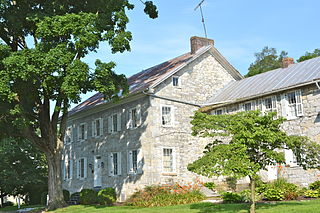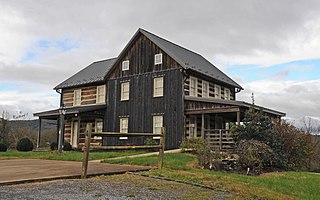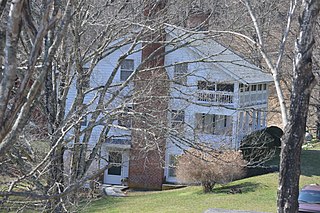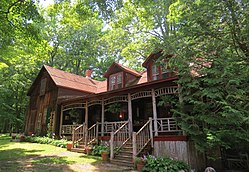
The Faeth Farmstead and Orchard District is a nationally recognized historic district located near Fort Madison, Iowa, United States. At the time of its nomination it contained 27 resources, which included 15 contributing buildings, three contributing sites, three contributing structures, and six non-contributing buildings. The contributing buildings include the farm house, the main barn (1882), a stable, a privy, engine house, smokehouse, chicken house, and hog house all from the early 1900s, a shop/crib, a second barn (1925), an apple packing shed, an apple cold storage shed or cooler with loading dock, a truck shed, a garage (1950s) and a machine shed. The contributing structures include a pond that was used for spraying apples, a spray tank/house (1946), and an old section of road. The contributing sites are the three historic orchards. The East Orchard was established before 1874 and it still has remnant older trees. The Old North Orchard was established around the turn of the 20th century, but the trees were primarily planted in the 1970s and the 1980s. The North Orchard was established in 1940-1941 and includes some remnant older trees and replacement trees from the 1970s to the 1990s. The non-contributing buildings are more recently built, or moved here in recent years.

The Almeron Durkee House is a historic house located at 13 Cayuga Street (NY-90) in Union Springs, Cayuga County, New York.
Peter Houghtaling Farm and Lime Kiln is a national historic district located at West Coxsackie in Greene County, New York. The district contains eight contributing buildings, one contributing site, and two contributing structures. The property includes a 1794 stone house, a well and smokehouse dated to about 1794, a 19th-century privy, three 19th-century barns, an early 20th-century equipment barn and chicken coop, and 19th-century burial ground. The lime kiln is constructed of battered walls of mortared rubble limestone. It was built between 1850 and 1880.
Union Bryarly's Mill is a historic flour and grist mill complex and national historic district located at Darkesville, Berkeley County, West Virginia, USA. It encompasses four contributing buildings and two contributing sites. The buildings are the Bryarly Mill, Mansion House, a log smokehouse and combination ice house building, the log miller's house (1751), the site of a distillery and foundation containing archaeological remains. The mill was built about 1835 and is a two-story, three-bay brick building with a gable roof. The Mansion House was built about 1835 and is a two-story, L-shaped frame dwelling on a stone foundation.

Culbertson–Harbison Farm is a historic home and farm complex located at Greene Township in Franklin County, Pennsylvania. The house was built between 1798 and 1800, and is a two-story, five-bay, limestone dwelling in the Federal style. It has a two-story, three-bay stone addition built between 1820 and 1840. Attached to the addition is a frame kitchen addition and brick smokehouse. Also on the property are the contributing large frame Pennsylvania bank barn with three hexagonal cupolas, a small frame privy, and other outbuildings.

Rock Hill Farm, also known as the Davis-Stauffer Farm Complex, is an historic, American home and farm and national historic district located in Montgomery Township in Franklin County, Pennsylvania.

The Stupp–Oxenrider Farm is an historic, American farm complex and national historic district that is located in North Heidelberg Township, Berks County, Pennsylvania.

The Joel Dreibelbis Farm is an historic American farm complex and national historic district that are located in Richmond Township, Berks County, Pennsylvania.

Siegfried's Dale Farm, also known as the Rodale Research Center or Rodale Institute, is an historic, American home and farm complex that is located in Maxatawny Township, Pennsylvania.

Ben Dover, also known as Ben Dover Farm, is a historic home and plantation complex, recognized as a national historic district, located near Manakin-Sabot in Goochland County, Virginia, United States. The district encompasses 13 contributing buildings, 8 contributing sites, and 10 contributing structures.

Brookside Farm and Mill is a historic grist mill and farm complex located at Independence, Grayson County, Virginia. The Brookside Mill was built in 1876, and is a three-story, three-bay by three bay, heavy timber frame building measuring 30 feet by 35 feet. The principal dwelling was built in 1877, and is a two-story, three-bay, frame building with a central passage plan. Other contributing buildings and structures include a brick spring house, brick smokehouse, log corn crib, frame hen house, miller's cabin, the miller's cottage or Graham House, a frame service station / garage (1918), and concrete dam (1914) and earthen mill race.

Pleasant Grove is a historic home and farm complex and national historic district located near Halifax, Halifax County, Virginia. The district includes 17 contributing buildings, 2 contributing sites, and 2 contributing structures on three farm complexes. They are the Main House Complex, Owen Tenant House Complex, and Ferrell Tenant House Complex. The main house was built in 1888–1890, and is a two-story Victorian style dwelling. Associated with it are the contributing smokehouse, pump house, watering trough, cow barn, granary, two corncribs, three tobacco barns, and a hog pen. The Owen Tenant House was built about 1900 and associated with it are a workshop, pumphouse, hog pen, and chicken house. The Ferrell Tenant House was built about 1940, and associated with it is a log corncrib. Also on the property are the ruins of the Blackstock Tenant House and a second tenant house ruin.
Samuel B. Stauber Farm is a historic farm complex and national historic district located near Bethania, Forsyth County, North Carolina. The district encompasses five contributing buildings dated between about 1852 and 1900. They include the two-story, three bay Greek Revival style farmhouse (1852); barn ; a slave dwelling ; a mid-to-late 19th century smokehouse; and a corn crib / granary.
Dean Farm is a historic farm complex and national historic district located near Louisburg, Franklin County, North Carolina. The district encompasses two contributing buildings, one contributing site, and two contributing structures. The farmhouse was built about 1842, and is a two-story, three-bay, Federal / Greek Revival style frame dwelling. It has a gable roof and two large single-shoulder gable-end chimneys of large stone blocks. Also on the property are the contributing smokehouse, corn crib, harness room, and family cemetery.
Speed Farm is a historic farm complex and national historic district located near Gupton, Franklin County, North Carolina. The district encompasses 14 contributing buildings, 2 contributing sites, and 5 contributing structures. The farmhouse was built about 1847 and remodelled to its current configuration in 1900. It is a two-story, three-bay, I-house style frame dwelling. It has a gable roof and an almost full-width front porch. Also on the property are the contributing milk house, smokehouse, kitchen, family cemetery, and an agricultural complex with a granary, ram tower, barn, corn cribs, hog shed, tobacco grading building, five tobacco barns, and a tenant house.

Joseph Freeman Farm is a historic farm complex and national historic district located near Gates, Gates County, North Carolina. The district encompasses six contributing buildings, one contributing site, and three contributing structures. The main house was built about 1821, and is a two-story, two-bay dwelling in a transitional Georgian / Federal style. A separate two-room kitchen/dining room ell was added about 1915. Associated with the house are the contributing smokehouse, privy, pump house, and domestic well. Contributing farm outbuildings include the lot well, equipment shelter, feed and livestock barn, and slave / tenant house.
John Phifer Farm is a historic farm complex and national historic district located near Cleveland, Rowan County, North Carolina, United States. The Jacob Phifer House was built in the 1850s, and is a two-story, rectangular, weatherboarded log dwelling. The oldest building is the John Phifer House, built about 1819, and is a small two-story log dwelling. Other contributing resources are the double-pen log barn, tool shed (1930s), garage, granary and corn crib, spring house, blacksmith shop, two chicken houses, log chicken coop (1930s), wood shed, smokehouse, privy, scalding vat, log tobacco barn, and the farm landscape.
Kotthoff-Weeks Farm Complex is a historic antebellum era home and farm located near Hermann, Gasconade County, Missouri. The farmhouse and barn were built between about 1850 and 1861, and are of heavy timber frame and stone buildings in the Fachwerk form. The house measures approximately 58 feet by 26 feet and features a stone chimney and fireplace. Also on the property is the contributing log smokehouse.

The West View Farm is a historic farm property on Hastings Road in Waterford, Vermont. The farm is unique for its distinctive round barn, built in 1903 to a design by St. Johnsbury architect Lambert Packard, and surviving 19th-century corn crib and smokehouse. The property was listed on the National Register of Historic Places in 1995. It includes a round barn.

















